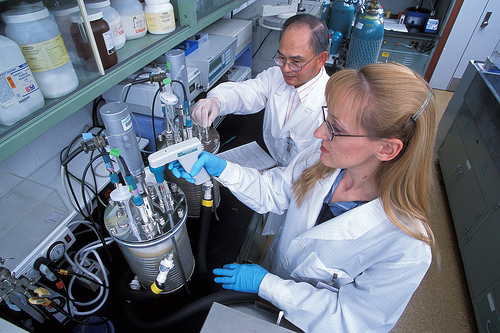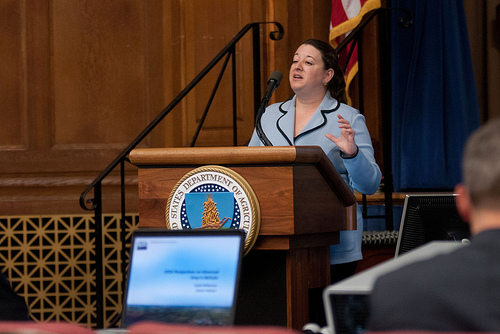
Diane Ley, State Executive Director, Hawaii Farm Service Agency, prepares to depart Hickam Air Force Base for the Great Green Fleet demonstration. USDA Photo.
WOW! The word “wow” only moderately conveys the historic events that unfolded this summer during the Department of Navy’s Rim of the Pacific Exercises (RIMPAC) Great Green Fleet (GGF) demonstration. The might and power of the United States Navy coupled with that of scores of other Pacific Rim counties was impressive, but moreover a number of the great ships and aircraft were fueled by a mix of algae and animal fats. Read more »

Agricultural Research Service chemist Tsung Min Kuo and technician Karen Ray convert vegetable oil into antifungal agents and other value-added bioproducts.
This post is part of the Science Tuesday feature series on the USDA blog. Check back each week as we showcase stories and news from USDA’s rich science and research profile.
Emerging bioenergy systems hold the promise of helping to reduce our dependence on foreign oil, increase economic prosperity, and reduce greenhouse gas emissions. The National Renewable Fuel Standard mandates the production of 36 billion gallons of biofuels be produced annually by 2022; of which 16 billion gallons must come from fuels that are not corn-based ethanol. These fuels, produced from the conversion of grasses, wood, and oilseeds and other biomass, must be produced in a sustainably and economically efficient manner. To meet this goal, USDA has developed a Bioenergy strategy, focused on research, development, education, and extension. As part of USDA’s Office of the Chief Scientist series of white papers on the Department’s research portfolio, this plan aligns USDA’s biofuels research with the goals of President Obama’s Blueprint for a Secure Energy Future. Read more »
As Americans joined family and friends to celebrate America’s independence, tens of millions took to our highways and Interstates – and I know that gas prices were on the minds of many.
President Obama understands the impact gas prices can have for families, and he is committed to an “all of the above” energy approach to solving our nation’s energy challenges – including reducing pain at the pump.
That includes developing the homegrown biofuels that save Americans money at the gas station and reduce our dependence on foreign oil. Read more »

ARS chemical engineer Akwasi Boateng (right) and mechanical engineer Neil Goldberg (center) adjust pyrolysis process conditions while chemist Charles Mullen (left) loads the reactor with bioenergy feedstock.
This post is part of the Science Tuesday feature series on the USDA blog. Check back each week as we showcase stories and news from USDA’s rich science and research portfolio.
Although corn is perhaps the most familiar player on the American biofuel scene, scientists with USDA’s Agricultural Research Service (ARS) say in the long run, barley and its byproducts could prove to be a viable renewable fuel option. Read more »

Senior Advisor to the Secretary of Agriculture Sarah Bittleman talked about the Agriculture perspectives on advanced drop-in biofuels, at the Industry Roundtable held in the Jefferson Auditorium, U.S.Department of Agriculture Headquarters in Washington, D.C., on Friday, May 18, 2012. Her talk discussed which feedstocks the USDA sees as coming advanced drop-in biofuels industry, what a transition from a food to a non-food related feedstock looks like and when/if they are required, and a detailed overview of the Commodity Credit Corporation (CCC) programs. USDA Photo by Lance Cheung.
Great things continue to happen as America moves forward in developing an “all of the above” strategy to become more energy independent. For example, an agreement was signed between aviation industry leaders and Midwest stakeholders to develop and commercialize sustainable biofuels. USDA will act as an advisor to this effort. Read more »
Cross posted from the White House blog:
Since taking office, President Obama has been committed to an all-of-the-above approach that expands production of American energy resources. Already, there are signs that this strategy is making an impact. Last year, domestic oil production reached the highest level in nearly a decade. Imports of foreign oil fell to the lowest level in 16 years. We’re producing more natural gas than at any time in our history. Since 2008, renewable energy generation from sources like wind, solar, and geothermal has nearly doubled. And the Obama Administration has supported the first nuclear power plant in thirty years.
Strengthening the domestic biofuels industry has been another critical component of this overall strategy. And today, U.S. biofuel production is at its highest level in history. In fact, average monthly production increased more than 40 percent between 2008 and 2011. That means more jobs – especially in rural America – and greater energy security. Read more »




